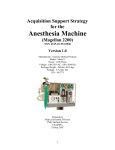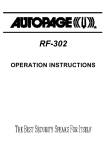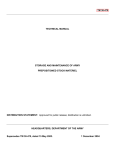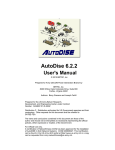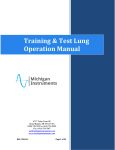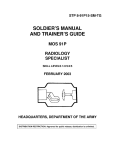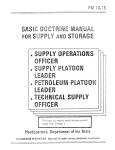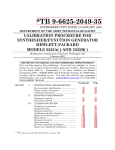Download 6515-01-435-0050
Transcript
Acquisition Support Strategy for the Suction Apparatus, Surgical NSN: 6515-01-435-0050 Version 1.0 Manufacturer: Impact Instrumentation, Inc. Model: 326M Power: 100 Watts Voltage: 115/230 VAC, 50-400 Hz Package Weight: 30 lbs (13.6 kg) Package: 1.85 cubic feet LIN: N/A Prepared by Acute Care Division PMO Medical Devices USAMMA June 2009 1 Acquisition Strategy The Suction Apparatus, Surgical is a commercial-off-the-shelf (COTS) portable medical suction device with rechargeable batteries that may be used for oropharyngeal, tracheal, wound drainage, and abdominal or thoracic decompression procedures requiring either intermittent or continuous suction. The Suction Apparatus, Surgical is authorized in the N301, Medical Materiel Set - Operating Room; N305, Medical Materiel Set – Radiology; N308, MMS Triage EMT Pre-Op; N309, Medical Materiel Set Post-Op ICU Ward; N310, Medical Materiel Set Intermediate Care Ward; N313, Medical Materiel Set Medical Services Clinic; N316, Medical Materiel Set Ob-Gyn Clinic; N513, Medical Materiel Set 84 Bed Combat Support Hospital; N713, Medical Materiel Set 164 Bed Combat Support Hospital. The acquisition strategy is to purchase 6 each per N301, 1 each per N305, 8 each per N308, 16 each per N309, 3 each per N310, 1 each per N313, 1 each per N316, 1 each per N513, and 1 each per N713 required set. The Suction Apparatus, Surgical is provisioned with all the necessary accessories and supplies. The system is purchased through ECAT vendor Impact Instrumentation, Inc., part number 8000326-04. It has an item cost of $1,855.79. This item is OMA funded. The life expectancy for the Suction Apparatus, Surgical is 10 years (TB MED 7). Operating costs 1 are $25 per year and maintenance costs are approximately $100 per year; therefore, the life cycle costs are calculated to be approximately $1,250 not including initial purchase costs. Clinical Application The Suction Apparatus, Surgical is used by healthcare personnel to clear body secretions such as mucus and blood, as well as fluids used for irrigation, from wounds, breathing passages and other locations on the body during surgery, postoperative care, and in other medical applications. Integrated Logistics Support (ILS) A. Maintenance Planning 1. Purpose: To provide a description of the requirements and tasks to be accomplished for achieving, restoring, or maintaining the operational capability of a system, or equipment. It covers the functions of preventive maintenance checks and services (PMCS) and associated schedule, periodic performance verifications and calibrations, and addresses the test, measurement, and diagnostic equipment (TMDE) used to care for the end item. Lastly, it addresses the maintenance levels of operations and those responsibilities of maintenance personnel therein. 2. Responsibilities: Biomedical and support maintenance can be performed by personnel holding the military occupational specialty 68-A, original equipment manufacturer (OEM), or OEM-trained civilian technicians. Reference material to be used by the 1 Consumable Supplies only 2 maintenance personnel includes, but is not limited to manufacturer’s, operator’s, and/or service literature. 3. Maintenance Procedures. 1. Field Support Maintenance: This item has been assigned a maintenance recoverability code (MRC) “O.” The system can be repaired and disposed of at the unit level. There are no special tools or procedures indicated that would hinder the unit maintainer from completely repairing the unit. See inspection procedures below, Section 4b. 2. Sustainment Support Maintenance: The sustainment level repair for this item will be at MEDLOG Company, which includes replacing subassemblies, rebuilding, and providing field support maintenance for medical units that do not have organic maintenance support. Use of medical equipment standby equipment program (MEDSTEP) materiel will be utilized when non-mission capable (NMC) days exceed N/A days or the unit’s assets fall below N/A percent availability. 3. Depot-level Maintenance: Depot-level maintenance for the system will be used when the system requires overhaul, refurbishment or a safety modification. 4. OEM Level Maintenance: Impact Instrumentation Inc. can provide complete maintenance repair and calibration, if needed. 4. Inspection Procedures: 1. This item has been assigned a type item code (TIC) “C.” This means prior to being issued from an USAMMA Maintenance Operations Division, this item will have a technical inspection to ensure it was received from the vendor according to the contract and that it functions within the guidelines set by the manufacturer and USAMMA. 2. The system is to be inspected on a scheduled basis in accordance with the published 10/20 PMCS or the manufacturer’s literature. 5. Tools and TMDE required for inspection: 1. Tool Kit, Medical Equipment, 5180-00-117-3414 2. Tool Set, Medical Equipment Maintenance Unit, 5180-01-483-1431 3. Safety System (Current Leakage), 6625-01-142-8233 4. Voltmeter, 6625-01-265-6000 5. Gas Flow Analyzer, 6515-01-491-6615 6. 10/20 Standards and MAC – See Appendix D 3 7. MEDSTEP: 1. MEDSTEP will be maintained at the MEDLOG Company or at one of the USAMMA Maintenance Operation Divisions. 2. MEDSTEP requirements will be based on one each per N/A system in the support area. That number may be subject to validation based on the condition of the equipment. 3. MEDSTEP requirements will be reevaluated on an annual basis. The support MEDLOG must be in possession of MEDSTEP in order to affect quick turnaround. 8. Repair Parts/Spare Parts Listing: Repair parts were determined using OEM and/or maintenance historical data. Spare parts can be obtained from existing stock or vendors. Spare parts packages will not be included with each system. See Section E. “Support Equipment” below for suction components. 9. Annual Man-hour Requirements 1. Field Support (1) Repair: (2) PM: (3) Safety: (4) Calibration: (5) TOTAL: 2.0 hours 1.4 hours .6 hours .6 hours 4.6 hours 2. Sustainment Support: Repair: 1.8 hours 10. Warranty Control Procedures. The Suction Apparatus, Surgical comes with a 1-year manufacturer’s warranty. The warranty includes parts and labor. When warranty service is needed, Impact Instrumentation, Inc. should be contacted at (973) 8821212. Their office is located at 27 Fairfield Place, West Caldwell, NJ 07006. 11. This system is not DA 2406 reportable. B. Training and Training Support 1. Maintainer: No additional training is required above the standard training received by the 68A at the biomedical maintenance course at the DOD Biomedical Equipment Training School. 2. Operator: Operator training for this system is part of the clinician’s standard training program. 4 C. Manpower and Personnel The fielding of the Suction Apparatus, Surgical will have no impact upon manpower or personnel structure. Operator and maintainer actions will be performed by the same soldiers currently performing similar functions. The total number of authorized operators or maintainers will neither increase nor decrease in the manpower/force structure area. The operator, MOS 68D (Operating Room Specialist) or MOS 66E (Operating Room Nurse), will perform operator checks and services. Field level maintenance will be performed by Medical Equipment Repairers, MOS 68A, assigned to the divisional medical companies and combat support hospitals. Sustainment level maintenance will be performed by the MOS 68A or civilian assigned to the Medical Logistics Companies. D. Supply Support Specific COTS support equipment and consumable items are required for the operation of the Suction Apparatus, Surgical. These are available through standard supply sources which are predominantly commercial manufacturers, vendors, and distributors cataloged in the Medical Supply Information Logistics System (MEDSILS) and available via the DSCP ECAT system. It is the responsibility of the Services to order these items via established logistics channels within DOD supply system. E. Support Equipment This Suction Apparatus, Surgical can be supported with supplies which can be ordered from Impact Instrumentation via the DSCP ECAT system (see table and pictures). Support NSN Mfg Part # Support Nomenclature (Long) 6515-01-509-6877 708-0326-01 Assembly Auto Power Cable 6515-01-511-7035 820-0018-00 Suction Hose 6’ Long, Clear, Sterile 6515-01-511-7034 540-0055-00 Hose, Clear, PVC, 18” Long 6515-01-511-7023 540-0068-00 Hose, Clear, PVC, 1’ Long 6515-01-511-7017 540-0051-00 Hose, Clear, PVC, 2’ Long 6515-01-504-3306 703-0326-06 AC/DC Power Supply 6515-01-509-8638 334-0030-00 Universal Canister Bracket 6515-01-503-9456 703-0326-07 Collection Canisters, 1000cc Reusable 6515-01-509-6967 402-0017-00 Padded Case., 2 ea. 6515-01-509-7331 334-0020-00 Straps, Velcro 6515-01-509-6977 703-0326-16 Carry-All Case with Label 5 6515-01-194-2187 465-0005-00 Hydrophobic/Bacteriostatic Filters 906-0326-03 Manual, Operation/Service F. Technical Data 1. Service Manual: Impact Service Manual, P/N 906-0326-03, Rev G. This is available in PDF and IETM via CD by going to the USAMMA website (http://www.usamma.army.mil/med_equip_lit_cdroms.cfm) and following the instructions or by calling DSN 343-4379 or commercial 301-619-4379. 2. Operator’s Manuals: Rev G. G. Computer Resources Support No computer resources are required. H. Facilities There are no unique facilities, shelter, or environmental compliance requirements. Warehouse storage is required prior to deployment to a unit. I. Packaging, Handling, Storage and Transportation The Suction Apparatus, Surgical is packaged in a hardened reusable container (IMPACT Instrumentation Part # 703-0326-16). It will be transported by vehicles organic to using organizations or by other transportation assets within the theater. There are no strategic lift constraints associated with this system. When transported (per MIL STD 1472), the system may be carried by one person. All support items are non-deteriorative. CHARACTERISTICS Storage temperature Operating temperature Relative humidity Dimensions (L x W x H), in Weight (lb) 5°F to 104°F (-15°C to 40°C) -20°C to 49°C ( -4°F to 120°F) 11.5 x 9.5 x 4.87 inches 5.5 kg (12 lbs) 6 J. Design Interface The Suction Apparatus, Surgical will interface with the electrical distribution system at the using organization. K. Requisition / Supply 1. The Suction Apparatus, Surgical is a non-stocked centrally procured item. The system will be provided during an initial fielding or sustainment fielding. Or if requested from the unit, procurement will be initiated only after receipt of a requisition. 2. AAC Code = L, which denotes LOCAL PURCHASE (Nonstocked items) - Defense Logistics Agency (DLA)/GSA/Service/ Agency-managed items authorized for local purchase as normal means of support at base, post, camp, or station level. Item not stocked in wholesale distribution system of IMM/Service/Agency ICP. 3. ARC Code = N, which denotes Class VIII items valued at $500 or more that retain their original identity and are not consumed in use and non-maintenance significant medical furniture items valued at $1,000 or more. 4. TIC Code = C, which denotes critical medical equipment requiring technical inspection. 5. Resupply items for this product are noted in the Supply Support and Support Equipment section. 7 Appendix A – Market Analysis MCMR-MMO-AC 5 February 2008 SUBJECT: Market Analysis for Surgical Suction Machines (Aspirators) 1. SUMMARY. Deployed clinicians have expressed dissatisfaction with the currently fielded suction machine because of excessive noise produced during use. A market survey was undertaken at the request of USAMMA to identify possible alternatives. Results indicated that there are less noisy suction machines available but only the currently fielded model meets all of the Essential Characteristics (ECs). The manufacturer of that product will be introducing an upgraded model later this year; however, the noise level associated with the new model is not expected to be substantially reduced below current levels. Several options for addressing the problem are presented. 2. RECOMMENDATIONS. There are several options for addressing the issues with the surgical suction machine, as indicated below. Clinicians should be consulted to determine the most suitable approach. Coordination with other services is advisable, given the implications for PMI. Option 1. Continue using the current model (Impact 326M) and phase in the (somewhat quieter) upgraded model (330M) when it becomes available (projected availability is 3rd or 4th Quarter 2008). Pros: Use of one multipurpose model simplifies logistical support (versus multiple models) COTS product is designed to withstand military environment and meets all ECs Cons: Wouldn’t improve noise situation much One-size-fits-all design may result in less reliable design for prolonged continuous use Option 2. Undertake a developmental effort to design a much quieter model that meets all the ECs. Pros: Would resolve noise problem (if successful) Cons: Time consuming and costly to develop No guarantee of success of product in non-military markets May increase size/weight of device Option 3. Revise the ECs so that alternative models can be considered (in combination) Pros: Would resolve noise problem Cons: Would require more than one model of suction machine to meet field requirements Alternative devices would likely be larger, heavier, and less suitable for field use (less durable) Option 4. Design an acoustical enclosure to reduce the noise level of the Impact Model(s) (*reportedly this was explored by the U.S. Army Medical Materiel Development Agency but not implemented). 8 Pros: Would resolve noise problem (if successful) Could continue to use present equipment and adapt for new model as needed Cons: Could pose concerns with respect to cleaning, performance reduction, overheating, etc. Adds to cube/weight of each system Requires some developmental effort Option 5. Implement a deployable central suction system similar to what is used in regular hospitals, with suction regulators provided/mounted as needed throughout the facility. Pros: Would resolve noise problem A workable system has been proposed by a manufacturer in the past (although not tested) Cons: If system fails, there would be no suction at all (or backup system might be needed) Additional logistical issues associated with developing, assembling, maintaining system Unsure of implications for size/weight, power consumption, etc. 3. BACKGROUND. Suction (vacuum) is needed for a variety of emergency, surgical, and other medical procedures to remove fluids and other debris that accumulate in the pharynx, respiratory tract, operative field, etc. Typically, in fixed facilities, medical suction needs are met through the use of a central vacuum system that provides vacuum to standard wall inlets via a pipeline system. Vacuum is then controlled via attached regulators throughout the facility. In the absence of such a central system, portable (mobile) suction systems, also referred to as aspirators, are used. Such systems typically consist of a vacuum pump, vacuum regulator and gauge (to aid clinicians in applying safe and appropriate suction levels), one or more collection canisters, an overflow protection assembly, and in some cases a bacterial filter for preventing fluid or aerosol contaminants from flowing back into the vacuum pump. Different types of portable/mobile aspirators are needed for a variety of applications in civilian clinics, emergency medicine, home health care, fixed hospital facilities (as backup), and a variety of deployed environments, such as field hospitals, ground ambulances, and rotary and fixed-wing aircraft. Critical parameters for medical aspirators include vacuum level/range and air aspiration rate. Values for these parameters vary among different device models depending on the clinical application. For example, emergency aspirators typically have high vacuum (~500 mm Hg) and high free flow (~25 LPM) settings for performing rapid oropharyngeal suction of vomitus and mucus. Lower settings may also beprovided for performing traumatic tracheal suctioning. These resuscitative types of units are relatively small and lightweight and usually powered with internal rechargeable batteries and/or vehicle (ambulance) power. By comparison, thoracic aspirators are available for evacuation of body fluids and/or air that accumulates in the pleural space following thoracic surgery, penetrating chest wounds, and other conditions. These aspirators generally have high-volume, lowvacuum pumps, are much larger, and are AC-powered. Surgical aspirators, the subject of this market analysis, provide moderate to high vacuum (200-500 mm Hg) and high flow rates (25-40 LPM), but also need to operate at lower vacuum levels to help prevent tissue damage. They also tend to be larger than the emergency units and most are AC-powered. Some suction models provide an additional intermittent mode capability, in which the unit cycles on and off for specified time periods (e.g., for chest tube drainage). The suction machine predominantly used in Army field hospitals is the model 326M from Impact Instruments (see below). It was originally developed primarily as a Patient Movement Item (PMI) for use during transport, but is now used as a multipurpose suction machine for virtually all applications, including surgical, post-op and ICU. A principal complaint about this model is that it 9 is very noisy (especially when multiple units are all operating simultaneously on a ward). In response to complaints from the field, the manufacturer added a type of muffler to reduce the noise level, but the device is still quite loud. According to the manufacturer, adding further sound insulation or noise limiting technology would increase the size/weight and degrade clinical and battery performance to an unacceptable level for the PMI environment. Model 326M suction apparatus, Impact Instrumentation NSN 6515-01-435-0050 Continuous and programmable intermittent modes 0-200 and 0-550 mm Hg vacuum 5-8 and 25 LPM air flow 12 lb, 9.5” x 11.5” x 4.9” 74 dB @ 1 ft Multiple power sources (AC, DC) $1600 A market survey was undertaken to determine whether there are any more suitable (and quieter) alternatives to the Impact model. Essential Characteristics (ECs) for the surgical suction apparatus are provided below. Some of the more critical ECs are as follows: • Shall be a multipurpose, continuous and programmable intermittent suction apparatus for oral, nasal, and tracheal suctioning during surgery, routine patient care and emergencies; evacuation of surgical site debris; and post-operative wound drainage • Shall have 30 LPM Free Airflow and provide two adjustable ranges of vacuum (low/intermittent mode: 0-200 mm Hg; high/continuous mode: 0-550 mm Hg), with safety lockout feature to prevent use of intermittent suction in the high vacuum range • When in intermittent mode, shall have timing ON/OFF cycles adjustable from 5-40 sec ON, 5-40 sec OFF • Shall be capable of operating from multiple types of power sources (including AC, external DC, and internal rechargeable batteries) • Shall meet requirements for Patient Movement Items (Joint Air Worthiness Certification) There are no ECs specifying limits for size, weight or noise level, but it is understood that these should be kept to a minimum, as with all equipment to be used in deployed environments. *Note: Some users have expressed a preference for specific types of collection canisters to be used with the surgical suction system, such as the model below (NSN 6515-01-106-7648), which has a built-in filter on top and uses disposable liners that fit into a hard reusable container. The ECs do not specify this type of system. 10 4. APPROACH/RESOURCES. Potential models and manufacturers of surgical suction units were identified from the online ECRI Product Comparison System, general searching of the Internet, and a 2007 Vendor Day at Fort Detrick. The Food and Drug Administration’s (FDA) 510(k) database was also searched for recent device approvals for suction machines (product code BTA). 5. FINDINGS. ECRI has Product Comparisons for four different classes of aspirators: emergency, surgical, thoracic, and uterine. For the surgical aspirator category, ECRI identified over 20 manufacturers of approximately 60 different models. Many of these models are marketed in countries outside the United States and are not cleared by the FDA. FDA-cleared surgical aspirators and their associated characteristics (identified by ECRI) are listed in Appendix A. None of those models meet the requirement to provide an intermittent suction mode. Also, all but one of them is designed to be operated solely from standard AC power. Because of this, a separate table of candidate suction machines (Appendix B) was constructed for suction machines that do have an intermittent mode (these models were not included in ECRI’s Product Comparisons but were identified from other sources). The information in Appendix B emphasizes the requirements of greatest interest to the military, rather than to ECRI, and the table excludes models for which the maximum vacuum level does not go above the “low” level (200 mm Hg). Photos of the devices considered are provided in Appendix C. 6. ANALYSIS. Only one model of aspirator meets all of the ECs – the currently fielded model (Impact 326M). Other (domestic) models that have both continuous and intermittent suction modes do not meet the criteria for maximum vacuum level or free air flow, are not operable from multiple power sources, have no internal battery, and would be unlikely to meet air worthiness requirements. They are also much larger and heavier than the Impact model. Some are much quieter than the 326M, but it should be noted that this is at least partly because the noise levels for the other models were measured at lower vacuum/flow levels because they are not designed to operate at the levels the Impact machine does. None of the internationally marketed models (i.e., non FDA-cleared) meet all of the ECs either. The only other potential product identified was one referenced in a 1978 report about a multipurpose suction pump designed at the USAF School of Aerospace Medicine for use on aircraft. No further information regarding the status of that device could be obtained. It should be noted that Impact will be introducing a next-generation suction machine similar to the 326M later this year (estimated around 3rd or 4th Quarter 2008). Expected specifications for the new device (model 330M) are included in Appendix B and an illustration in Appendix C. The new model is expected to meet all of the ECs but will only be slightly quieter than the present model. Some of the major design improvements will include the following: 11 • • • • • • • Switching from brush type motor to permanent magnet motor – this will result in the motor running cooler and will prevent sparks (according to Impact, this addresses an Air Force change in conops where they will use “aircraft-of-opportunity” for Medevac, which could result in residual fuel fumes being present) Changing from lead acid to lithium ion battery pack and incorporating a rapid charger (reduces size/weight, reduces charge time to ~ 2 hours) Extending external DC input voltage to 11-31 VDC (makes compatible with all types of vehicles and aircraft without need for external adaptors) Provides micro drainage feature to help prevent ventilator associated pneumonia Produces twice the maximum flow of the 326M Uses less power/has longer battery life Incorporates LCD display, advanced alarm and status indicators, night vision goggle compatible mode Future Trends. According to ECRI, surgical aspiration is a mature technology with limited potential for innovation other than new surgical waste disposal systems that do not utilize canisters at all, making waste collection easier, safer, and more cost-effective. These systems consist of a rover (mobile collection tank), and a docking station (wall unit). After surgery, the rover is transported and connected to the docker, which is capable of sterilizing and disposing of the waste. Clinicians have not indicated any interest in this type of technology for the field at this time. 7. CONCLUSIONS. Impact’s new suction model is expected to be an improvement over the current one in a number of respects, but will not substantially reduce the noise level below that of the currently fielded device. The only other options for meeting the requirements for suction in the field are to develop a new device (possibly via modification of an existing product) or to modify the requirements such that multiple models with different characteristics can be used in combination to meet varying clinical needs. Clinicians should discuss which of these approaches is the most appropriate. If the latter approach is selected, Appendices A and B could be used to facilitate discussion, revisions to requirements, and product down-select. Given that the equipment is used for PMI, other services should be engaged in the process. 8. REFERENCES. Aspirators, Surgical, ECRI Institute, Healthcare Product Comparison System, 2007. 9. APPENDICES. 12 Essential Characteristics for Surgical Suction Machine (1) Shall be a multipurpose continuous and programmable, intermittent suction apparatus for oral, nasal, and tracheal suctioning during surgery, routine patient care and emergencies; evacuation of surgical site debris, and post-operative wound drainage. The apparatus shall be capable of operating from multiple power sources including a component battery. (2) Shall consist of at least the following items: (a) Fuse, Midget, 2A, 250 Volt, (2 each). (b) Strap, Hook & Loop, 1 inch Wide by 24 inch Long,(2 each). (c) Holder, Collection Bottle, Chrome Plated, (2 each). (d) Case, Padded, Aspirator, W/O Accessories, (1 each). (e) Filter, Hydro/Bact, Disposable, W/Hose, Barbs, (2 each). (f) Hose, 2 Ft Long, (2 each). (g) Hose, 18 inch Long, (2 each). (h) Hose, 12 inch Long, (1 each). (i) Assembly, AC Charger Rectifier, (1 each). (j) Assembly, Collection Canisters, (2 each). (k) Assembly, Carry Case, Hard, 7 inch, (1 each). (l) Assembly, Auto Power Cable, (1 each). (m) Tubing, Suction, Sterile, 9/32 inch ID by 6 Ft Long, (1 each). (n) Manual, Operation/Service, (2 each). (3) Shall have a separate AC power supply. The AC power supply shall contain an input voltage selector switch to allow selection of either 110-125 volts AC, 50-400 Hz, single phase service or nominal 220-250 volts AC, 50-400 Hz, single phase service. (4) Shall be operational from a 12-volt internal battery and from external DC sources of 11-30 volts including vehicle generating system rated 120 amperes at 14-volts; 120 amp-hour heavy duty 12-volt battery, and aircraft 28-volt generating system. (5) Shall be capable of operating from any of the specified external AC or DC power sources while the internal battery is being recharged via the component battery charging circuit. Simultaneous operation and recharge shall not effect recharge time. (6) A vehicle power cord assembly shall be provided, approximately 6 feet long, having a vechicle cigar lighter plug on one end and a mating suction apparatus plug on the other end. (7) The suction apparatus shall provide two adjustable ranges of vacuum. The low range shall be adjustable from 0 to a maximum of 200 mmHg for intermittent suction procedures. The high range shall be adjustable from 0 to at least 550 mmHg for continuous high vacuum procedures. (8) In the low vacuum range, the unit shall be capable of being user programmed to provide various combinations of intermittent timing cycles. Intermittent timing cycles shall be within the range limits of the ON and OFF time controls. Time cycle controls shall be adjustable from at 13 least 5 to 40-seconds ON and at least 5 to 40-seconds OFF. The ON and OFF time cycle controls shall be independent of each other. Panel markings for each control shall be labelled in increments not to exceed 5-seconds. When set for high range, the unit shall provide the selected vacuum continuously. (9) The suction system shall provide for at least the following: (a) Controls: (1) (2) (3) (4) (5) (6) (7) Mode Control Switch - OFF/CONTINUOUS/INTERMITTENT. ON Time Selector Control - Continuously variable, at least 5 thru 40 seconds. OFF Time Selector Control - Continuously variable, at least 5 thru 40 seconds. Vacuum Adjust Control - Continuously variable over the low and high ranges. DC Voltage Protector - Fuse or circuit breaker. AC Voltage Protector - Fuse or circuit breaker. Safety Lockout - No intermittent suction in high range. (b) Indicators: (1) Battery Charge Indicator - Analog meter depicting zones indicative of "battery charged" and "battery charge low". (2) Luminous Battery Charging Indicator - Denoting presence of battery charging current. (3) Vacuum Gauge - Dual scale, metric and English. (c) Minimum Capabilities: (1) Intermittent Low Vacuum - Variable from 0 through a maximum of 200 mmHg. (2) Continuous High Vacuum - Variable from 0 through at least 550 mmHg. (3) 30 LPM Free Airflow - Patient end of 5 feet tube. (4) Battery Operating Time - 2 hours (minimum) when cycled as follows: 2 minutes @ 120 mmHg 1 minute @ free airflow 2 minutes @ 120 mmHg 1 minute OFF After completing 20, 6 minute cycles, free airflow shall measure at least 30 liters per minute and the analog battery charge indicator shall indicate that additional battery charge remains to provide at least two additional 6 minute cycles. (d) Depleted Battery Recharge Time - Maximum 24 hours @ 22 Degrees C +/- 1 Degrees C. (e) Intermittent Cycle Combinations - All combinations between 5 and 40 seconds ON and 5 and 40 seconds OFF with 1-second resolution capability. (f) Compatible with collection system(s) defined herein. 14 (10) The suction apparatus case shall include an integral carrying handle, attachment interface for two (2) collection canisters and mounting bracket interface. Without collection canisters attached to their respective case mounting brackets, the suction apparatus shall be operable in at least three (3) positions: Upright(handle oriented upwards at top of case), Laying Flat (clear door oriented upwards), or On Its Side (clear door may be opened, and controls are accessible by operator) without any degradation in performance. The suction apparatus, with attached collection canisters, shall be completely transportable with only one hand via its integral carrying handle. (11) The suction apparatus shall include affixed brackets that accommodate attachment of the universal canister attachment brackets. (12) The universal canister attachment bracket shall be capable of holding the reusable canister described herein and disposable canister with individual capacities of at least 2000 milliliters each. (13) The suction apparatus case shall include a mounting bracket interface that permits the apparatus, complete with dual collection canisters, to be attached to aircraft stanchions, stretchers, gurneys, bulkheads, rail mounting systems, carts and/or poles up to 1 inch in diameter. (14) A clear patient suction tube at least 5 feet long and collection canister connecting tubing shall be provided. (15) Two (2) reusable collection canisters and two (2) universal canister brackets shall be provided. Collection canisters shall be configurable to operate singly or in tandem with one another. Each canister shall include an overflow shutoff valve cartridge that can be removed and reinstalled without the use of tools to facilitate and make possible tandem use. (16) Collection canisters shall be constructed from clear, nonbreakable, autoclavable material. Glass is not acceptable. Canister lids shall be self-sealing to prevent leakage and be autoclavable as well. Tube fittings and the overflow shutoff valve cartridge and any other components comprising the complete collection canister/lid assembly shall be autoclavable. (17) Shall be fully provisioned in accordance with the DEPMEDS provisioning code "D" to include: DI-ILSS-80865 MEDICAL SUPPORT KIT LISTS DI-ILSS-80868 SPECIAL EQUIPMENT TOOLS AND TEST EQUIPMENT DPSC-A SPECIAL EQUIPMENT COMMERCIAL SERVICE MANUAL DPSC-B SPECIAL EQUIPMENT COMMERCIAL OPERATING/ INSTRUCTION MANUAL DI-V-7000A SUPPLEMENTARY PROVISIONING TECHNICAL DOCUMENT DI-V-7009A DESIGN CHANGE NOTICE DI-ILSS-80867 SPECIAL EQUIPMENT CONSUMABLE/DURABLE SUPPORT ITEMS LIST 15 (18) Shall contain two (2) sets of operating/maintenance manuals. (19) Unit of issue shall be each. (20) Potential Patient Movement Items (PMI) considered for usage aboard military aircraft shall have a Joint Airworthiness Certification (JAC) consisting of a safe-to-fly letter from the U.S. Air Force and a Fleet Airworthiness Release (AWR) and an Aeromedical Certification Letter from the U.S. Army. The potential PMI shall comply with the following JAC requirements. Military standards shall be interpreted as though all units of PMI could be used aboard military aircraft, and should comply. (a) Baseline Performance Assessment: When the device first arrives, the test engineers conduct a review validating the device functions as advertised and as expected. Battery test (discharge and recharge) will be repeated three (3) times to obtain a mean value. The assessment familiarizes evaluation personnel with operation and characteristics of the device, noting design weaknesses and potential safety hazards relating to the aeromedical environment and human factors such as man-machine interface and potential for operator error (MIL-STD-1472). (b) Electrical Safety (ANSI/AAMI ES1-1999) for leakage current, ground resistance, and other medical equipment safety concerns. In addition, power receptacles should have a locking feature to prevent inadvertent disconnects from the power source. (c) Vibration Testing (MIL-STD-810F): Please contact USAMMA, PM Medical Devices for information on vibration testing. 16 Appendix B – Standardization Efforts N/A 17 Appendix C – Testing and Airworthiness The suction apparatus is airworthiness certified for flight on the UH-60A, UH-60L, HH60A, & HH-60L. 18 Appendix D – 10/20 Standards and MAC Chart Operator’s Preventive Maintenance Checks and Services 6515-01-435-0050 Suction Apparatus, Surgical Impact 326M Series B-Before Operation, D-During Operation, A-After Operation, Q-Quarterly, and S-Semiannually] ITEM INTERVAL NO 1 B ITEM TO BE INSPECTED AND PROCEDURE Suction Apparatus a. Conduct an inventory to ensure that the items listed in the Equipment Parts and Accessories List are on hand - Battery, rechargeable - Case, Carry Hard Side - Case, Carry Soft Side - Literature Operator - Spare Fuse - Collection Canister Assembly - Cable Power Charger AC/DC - Cable Power 12-volt Lighter Outlet - Velcro Strap - Bracket Assembly - Tubing 72”, 24”, 12”, 18”, 72” 50/pg, - Filter Hydrophobic 19 IS NOT MISSION CAPABLE IF: Missing components or accessories would prevent the full operation of the suction apparatus. ITEM INTERVAL NO B,A 2 B, A ITEM TO BE INSPECTED AND PROCEDURE b. Inspect the Suction Apparatus - Exterior case housing for cleanliness, housing is not damaged and is intact, clear of any spilled fluids. - AC Power Supply for signs of damages, plug blades are not bent. - Line cord for signs of cracking, damage. - All tubing, insure they are not cracked, crimped or dirty. - All fittings and connectors for excessive wear or leaks. - Controls and switches to verify correct alignment and positive stopping, damages, loose mounting and inappropriate motion. - Battery pack for corrosion and damages, battery charge indicator is reading, battery is being charged. - Indicators and displays - Vacuum gauge for cracks and scale visibility and that the indicator rest on zero without vacuum being applied. - Labeling is intact and legible. - Canister has no cracks, chips, leaks Performance Checks - Verify operating power selection from external power sources or internal rechargeable batteries. - Ensure all suction tubing and canister lid are properly secured. - Charge lamp should illuminate during operation if external operating power is applied. - Turn power and mode selector switch to CONtinuous, the pump should run. - Turn power and mode selector switch to INTermittent operation, set ON/OFF times for 5 seconds on and 5 seconds off, pump should run 5 seconds then turn off for 5 second then back and forth for 5 seconds each. - Adjust vacuum regulator verify that the vacuum level can be adjusted. 20 IS NOT MISSION CAPABLE IF: Housing is not intact. Plug blades are bent. Line cord insulation is cracking. Battery corrosion is present. Canister lid is not secure. Time on or off exceeds 5 ± 2 seconds. ITEM INTERVAL NO 3 B, A ITEM TO BE INSPECTED AND PROCEDURE Battery Pack - For long-term storage the battery should be disconnected from the suction apparatus. - To provide long life and maximum performance fully charge the batteries for a minimum of 16 hours. - The suction apparatus should operate from its internal battery pack without disconnecting the external power cord from its respective jack. 21 IS NOT MISSION CAPABLE IF: Maintainer’s Preventive Maintenance Checks and Services 6515-01-435-0050 Suction Apparatus, Surgical Impact 326M Series [M-Monthly, Q-Quarterly, S-Semiannually, and A-Annually] ITEM INTERVAL NO 1 S ITEM TO BE INSPECTED AND PROCEDURE Suction Apparatus a. Conduct an inventory to ensure that the items listed in the Equipment Parts and Accessories List are on hand - Battery, rechargeable - Case, Carry Hard Side - Case, Carry Soft Side - Literature Operator - Spare Fuse - Collection Canister Assembly - Cable Power Charger AC/DC - Cable Power 12-volt Lighter Outlet - Velcro Strap - Bracket Assembly - Tubing 72”, 24”, 12”, 18”, 72” 50/pg, - Filter Hydrophobic b. Inspect the Suction Apparatus - Exterior case housing for cleanliness, housing is not damaged and is in tact, clear of any spilled fluids. - AC power supply for signs of damages, plug blades are not bent. - Line cord for signs of cracking, damage. - All tubing, insure they are not cracked, crimped or dirty. - All fittings and connectors for excessive wear or leaks. - Controls and switches to verify correct alignment and positive stopping, damages, loose mounting and inappropriate motion. - Battery pack for corrosion and damages, battery charge indicator is reading, battery is being charged. - Indicators and displays - Vacuum gauge for cracks and scale visibility and that the indicator rest on zero without vacuum being applied. - Labeling is intact and legible. - Canister has no cracks, chips, leaks 22 IS NOT MISSION CAPABLE IF: Missing components or accessories would prevent the full operation of the suction apparatus. Housing is not intact. Blades are bent. Line cord insulation is cracking. Battery corrosion is present. ITEM INTERVAL NO 2 3 S S ITEM TO BE INSPECTED AND PROCEDURE Performance Checks - Verify operating power selection from external power sources or internal rechargeable batteries. - Ensure all suction tubing and canister lid are properly secured. - Charge lamp should illuminate during operation if external operating power is applied. - Turn power and mode selector switch to CONtinuous, the pump should run. - Turn power and mode selector switch to INTermittent operation, set ON/OFF times for 5 seconds on and 5 seconds off, pump should run 5 seconds then turn off for 5 second then back and forth for 5 seconds each. - Adjust vacuum regulator verify that the vacuum level can be adjusted. Rate of Vacuum Rise - With collection canister in place - Patient fitting is occluded - Verify the time it takes to reach 300 mmHg - Should not take longer than 4 seconds Maximum Vacuum - With collection canister connected - Vacuum adjust control set to maximum - Occlude patient fitting - The unit should produce 550 mmHg of vacuum SA Canister lid is not secure. Time on or off exceeds 5 ± 2 seconds. Battery Pack - For long-term storage the battery should be disconnected from the suction apparatus. - To provide long life and maximum performance fully charge the batteries for a minimum of 16 hours. - The suction apparatus should operate from its internal battery pack without disconnecting the external power cord from its respective jack. Maximum Flow - Measure the maximum free airflow with a flowmeter - Perform this test with the canister connected - Verify 30 liters per minute free airflow 4 IS NOT MISSION CAPABLE IF: Calibration 23 Flow is less than 25 L/min. Does not reach 300 mmHg. Does not reach 550 mmHg. ITEM INTERVAL NO ITEM TO BE INSPECTED AND PROCEDURE Maximum Low Vacuum Level Limit - Using fully charge batteries turn the unit on - Select INT operation - Turn vacuum adjust control to maximum - Occlude vacuum inlet fitting, adjust R20 until front panel vacuum gauge reads 200 mmHg - Verify reading by using the gas flow analyzer reading should be within 10% of each other Intermittent ON/OFF Timing Circuit - Using fully charged batteries turn the unit on - Select INT operation - Turn vacuum adjust control to maximum - Set ON/OFF times for 5 seconds On and 5 Off - Verify times with a stop watch 5 Low Battery Indicator Adjustment - Disconnect and remove battery pack from aspirator - Preset external power supply for 12 VDC and attach to aspirator battery connector - Turn external power supply on - Set Mode switch to CON - Adjust external power supply for 11.1-volts - Adjust R36 on the Main PCB until the low battery indicator needle is centered directly between the red and green divisions. - Disconnect the external power supply, reconnect the battery pack. Perform Safety test - Using a leakage current meter check that the leakage current does not exceed 100 microamperes - Ground resistance should not exceed 0.5 ohms 24 IS NOT MISSION CAPABLE IF: Not in the limit established. On or off time exceeds 5 ± 2 seconds. Fails safety test. Maintenance Allocation Chart 6515-01-435-0050 Suction Apparatus, Surgical Impact 326M Series FM – Operator, Unit Maintenance; SM – MEDLOG or Depot Maintenance (1) (2) Group # Assembly Group (3) (4) Maintenance Function Maintenance Level (5) Tools and TMDE Code 1 Aspirator Inspect, replace Repair FM,SM FM, SM 01, 06, 20, 21 2 Main PCB Inspect, Replace Repair FM SM 01 3 Pump Inspect Replace, Repair FM SM 01 4 Regulator PCB Repair, Replace SM 01,06,21,20 5 Switcher PCB Inspect, Replace SM 01,06,21,20 6 Manifold Assembly Inspect, Replace Repair FM SM 01,06,21 7 Connector Panel Inspect, Replace FM 01 8 Battery Pack Inspect, Replace FM 01,20 9 Collection Canister Inspect, Replace FM 10 External Power Supply Inspect, Replace, Repair FM SM 25 01 01,06,21,20 (6) Remarks Tools and TMDE Code Listing for Maintenance Allocation Charts Reference Code 01 02 03 04 05 06 07 08 09 10 11 12 13 14 15 16 17 18 19 20 21 22 23 24 25 26 27 28 29 30 31 32 Item / Nomenclature NSN Model Tool Kit, Medical Equipment Maintenance Repairer Tool Set, Medical Equipment Maintenance Unit Level Tool Set, Medical Equipment Maintenance Direct Support Level Tool Set, Medical Equipment and Maintenance General Support Level 5180-00-611-7923 Individual 5180-01-483-1431 Unit Level (alt: Org Maint) 5180-01-483-2185 Direct Support 6545-01-482-2907 General Support (alt: Shop Set, Bn Med Maint) Multimeter Radiographic X-ray Calibration & Verification System Gas Flow System / Calibrator Gas Flow 6525-01-387-0212 6625-01-312-0894 PMX-III Victoreen 6515-01-491-6615 6695-01-255-2855 VT-Plus RT-200 Anesthetic Gas System TBD CO2 System System NIBP IV Pump System Defibrillator System TPA Tester Defibrillator Counter, Electronic Digital Densitometer, SU150/P Calibrator Generator, ECG Simulator, Medical Function Signal Generator Computer, Laptop Foot Candle Meter Thermometer Multimeter, AN/PSM-45A Multimeter, AN/USM-486 Oscilloscope, Digital Oscilloscope Oscilloscope Radiometer, Ultrasound Therapy 6630-01-487-6987 Riken 1802D P/N 19-3325 6515-01-449-1423 6515-01-449-2331 6515-01-499-1420 6625-00-433-9063 6515-01-271-3012 6525-01-161-1975 6515-01-049-9449 6625-01-298-3830 6625-01-276-9421 Various 6695-01-303-0294 6625-01-296-4006 6625-01-265-6000 6625-01-145-2430 6525-01-448-9577 6625-01-187-7847 6625-01-258-0022 6625-01-141-7357 6625-01-487-6986 2820 Cufflink IPT-1 Impulse 4000 DT2000A AN/USM-459A 07-423 ECG 100 215M SG-1288/G Various 9-118 TK 80 27/FM 8050A THS720P 2235L 2430A UMR 3-C UMR 3-D 6515-01-449-1422 6680-01-307-8190 6525-01-039-4019 6625-01-255-0839 6625-01-042-8213 6625-01-142-8233 Cardiosat EF 1893A 07-467 HTR2000/Huntron RF302 232M 6515-01-449-1421 Pneuview 360001 TBD Simulator, Pulse Oximetry Tachometer, Stroboscopic Test Cassette, X-Ray Test Set, Electronic Test Set, Electrosurgical Tester, Current Leakage TBD Tester, Ventilator TBD 26 Appendix E - Reference N/A 27



























